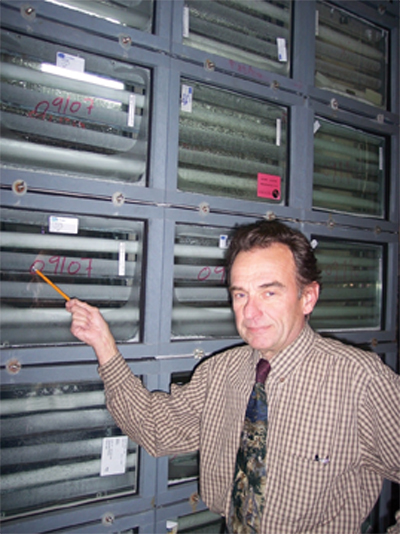
Fenestration is an architectural term that refers to the arrangement,
proportion, and design of window and door systems within a building.
These “controlled” openings in the building envelope that permit the
passage of air and light also serve to enable entry and egress of
people.
Fenestration is an architectural term that refers to the arrangement, proportion, and design of window and door systems within a building. These “controlled” openings in the building envelope that permit the passage of air and light also serve to enable entry and egress of people. They also enhance the exterior and interior appearance of buildings. The word finds its root in the Latin word for window – Fenestra. (If you really want a good laugh search for “defenestration” on the web.)
 |
|
| Brian Burton in front of weather cycling testing apparatus for IG units.
|
Fenestration components include glazing materials, either glass or plastic; framing, mullions, muntins, dividers, opaque door slabs; external shading devices; internal shading devices; integral (between-glass) shading systems, skylights and solar tubes. I include doors in this list of components because they are operable, allowing entry or egress and many have glazing components.
Fenestration can serve as a physical and/or visual connection to the outdoors, as well as providing a means to admit solar radiation. The solar radiation provides natural lighting, referred to as daylighting, and heat gain to a space. Fenestration components can be fixed or operable, and operable units can allow natural ventilation to a space and egress in low-rise buildings.
Fenestration components also serve to separate the indoor and outdoor environment and as such are subject to all of the elements of the outdoor environment including freeze thaw cycling, UV radiation, rain, snow, heat stress, wind, impact, acid rain and forced entry. On the other side of the coin the components are exposed to all of the conditions on the interior including humidity, condensation, temperature variations and the effects of occupancy. We are talking here about a “tall order” to say the least. Also often overlooked is the important function these components play in occupant comfort and safety which building scientists consider one of the most important functions provided by the building enclosure.
We know that ability to control fenestration components is very important to the building occupant. The same is true for the “view” or visual connection to the outside. Technology has granted us the means, and we have come to expect more control over nearly everything in our environment that affects us –and that includes doors and windows.
As the readers of Glass Canada know it is a recognized scientific discipline with the field of architectural and building science and it is an extremely complex and demanding one.
Designing and properly constructing an indoor environment that is healthy, comfortable, durable and energy efficient requires an understanding of the complex relationships between occupant, building, machines and nature.
Fenestration affects building energy use through four basic mechanisms: Thermal heat transfer, solar heat gain, air leakage and daylighting.
Fenestration components go well beyond being simple devices that let in light and air. Today they function as integral components of complex building envelopes, selectively filtering aspects of the larger environment. As manufacturers have developed new technologies to improve visibility, security, and comfort, windows have become elements of sophisticated systems that control light, ventilation, moisture, dust, sound, and even infrared and ultraviolet light.
Consider these few examples of how complex fenestration has become.
Liquid Crystal Device Windows, a variant of the liquid crystal display technology used in wristwatches is now serving as privacy glazing for new windows. A very thin layer of liquid crystals is sandwiched between two transparent electrical conductors on thin plastic films and the entire emulsion or package (called a polymer dispersed liquid crystal device) is laminated between two layers of glass. When the power is off, the liquid crystals are in a random and unaligned state. They scatter light and the glass appears as a translucent layer, which obscures direct view and provides privacy. The material transmits most of the incident sunlight in a diffuse mode, thus its solar heat gain co-efficient remains high.
Suspended Particle Device (SPD) windows have electrically controlled film that utilizes a thin, liquid-like layer in which numerous microscopic particles are suspended. In its unpowered state the particles are randomly oriented and partially block sunlight transmission and view. Transparent electrical conductors allow an electric field to be applied to the dispersed particle film, aligning the particles and raising the transmittance.
Global demand for fenestration products is expected to hit the $125 billion mark in 2009. North America, Western Europe, and Japan account for 75 per cent of global demand.
Here in Canada, as most readers will know, we have a long background of innovation, standardization and testing of fenestration products for a wide range of performance characteristics.
This is a growing industry fuelled by innovative technology and I look forward to talking about fenestration in my future columns.
* Brian Burton is the business development manager for Can-Best Building Envelope Science and Technology and is a frequent contributor to North American trade publications in the field of building science. He can be reached at brian@can-best.com .
Print this page
Leave a Reply